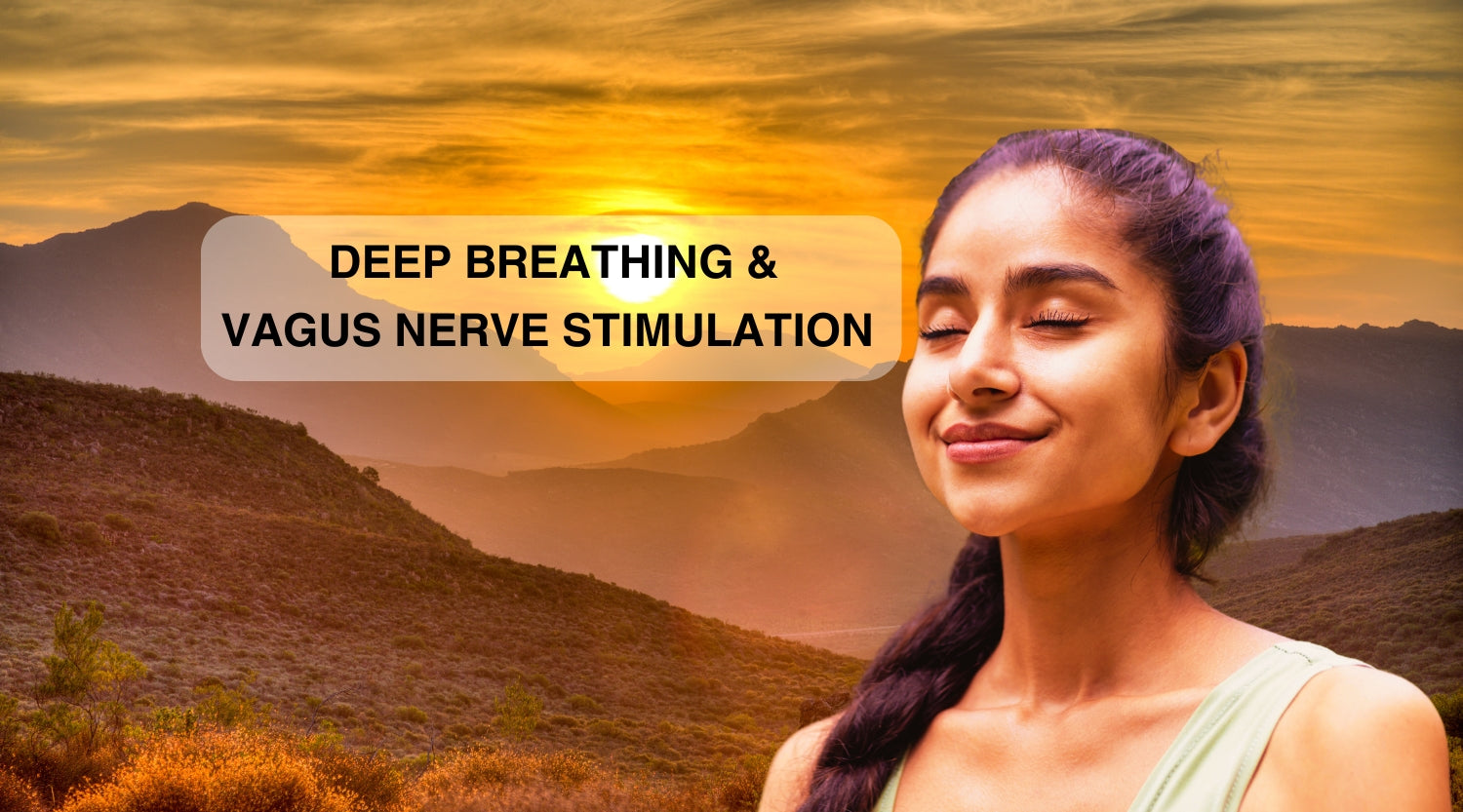
How Deep Breathing and Vagus Nerve Stimulation Improve Vagal Tone
The vagus nerve, a component of the parasympathetic nervous system, is essential for maintaining our body's homeostasis. It is also known as the "wandering nerve" because it connects the brain to other organs, such as the heart, lungs, and digestive system. The health and responsiveness of this nerve are assessed by vagal tone, which represents our body's capacity to transition between states of rest and activity. A greater vagal tone is related to better physical and mental health, while a lower vagal tone can be a precursor to a variety of health issues. In this blog, we'll explore how deep breathing and vagus nerve stimulation (VNS) can significantly enhance vagal tone, leading to better overall health.
Understanding Vagal Tone
What is Vagal Tone?
Vagal tone is the activity of the vagus nerve and its capacity to control the body's internal organs. It is frequently assessed using heart rate variability (HRV), which is the time interval between each pulse. Higher HRV indicates a healthy parasympathetic nervous system, which implies the body can efficiently regulate stress, recuperate from effort, remain calm and balanced.
Why is Vagal Tone Important?
A strong vagal tone is required to maintain a healthy balance between the sympathetic (fight or flight) and parasympathetic (rest and digest) branches of the autonomic nervous system. When the vagal tone is robust, the body is better able to deal with stress, minimize inflammation, and promote mental wellness. In contrast, decreased vagal tone has been associated with persistent stress, anxiety, depression, and inflammatory diseases.
Deep Breathing and Vagal Tone
The science behind deep breathing explains how stress chemicals like cortisol transform into stress hormones
Deep breathing is a simple yet effective method that directly affects the autonomic nervous system. Deep breathing relaxes the diaphragm and activates the vagus nerve, resulting in enhanced parasympathetic activity. This reduces heart rate, blood pressure, and stress chemicals like cortisol. Studies have found that deep, slow breathing (usually 5-7 breaths per minute) dramatically improves HRV, which is a clear signal of increased vagal tone. This technique not only relaxes the mind but also promotes physiological coherence, in which the heart, mind, and breathing system operate in tandem.
Types of Breathing Techniques to Improve Vagal Tone
- Diaphragmatic Breathing: This method, also known as belly breathing, involves deep abdominal breathing to completely activate the diaphragm. This sort of breathing is very efficient for activating the vagus nerve.
- Box Breathing: Inhale for four counts, hold for four, exhale for four, then repeat for four counts. Navy SEALs employ this strategy to remain calm and focused under pressure.
- 4-7-8 Breathing: Popularized by Dr. Andrew Weil, this technique involves inhaling for a count of four, holding the breath for seven counts, and exhaling for eight counts. It is particularly effective for reducing anxiety and improving sleep.
Practical Tips
To incorporate deep breathing into your daily routine, set aside 5-10 minutes each day for practice. Find a quiet space, sit or lie down comfortably, and focus on your breath. Start with diaphragmatic breathing and gradually experiment with other techniques like box breathing or 4-7-8 breathing. Consistency is critical to reaping the full benefits of these practices.
Vagus Nerve Stimulation (VNS)
What is Vagus Nerve Stimulation?
Vagus Nerve Stimulation (VNS) is a method used to activate the vagus nerve, thereby enhancing vagal tone and promoting overall health. VNS can be achieved through various techniques, ranging from simple lifestyle practices to medical interventions.
Non-Invasive Vagus Nerve Stimulation Techniques
- Cold Exposure: Exposing the body to cold, such as through cold showers or splashing cold water on the face, can stimulate the vagus nerve. The sudden change in temperature triggers the dive reflex, which slows the heart rate and activates the parasympathetic nervous system.
- Gargling and Singing: Engaging the throat muscles by gargling or singing can stimulate the vagus nerve, as these activities activate the muscles connected to it.
- Acupuncture and Massage: Certain acupuncture points and massage techniques, particularly around the neck and shoulders, can help stimulate the vagus nerve and improve vagal tone.

Medical VNS Devices
For individuals with certain medical conditions, such as epilepsy or depression, medical VNS devices may be prescribed. These devices are surgically implanted and deliver electrical impulses to the vagus nerve. Emerging research suggests that non-invasive VNS devices, which do not require surgery, may also be effective in improving vagal tone and treating conditions like anxiety and chronic pain.
The Synergy Between Deep Breathing and VNS
How Deep Breathing Enhances VNS
Deep breathing can amplify the effects of vagus nerve stimulation by naturally increasing parasympathetic activity. When combined with VNS techniques, deep breathing creates a powerful synergy that can significantly enhance vagal tone, leading to improved autonomic regulation and overall well-being.
Real-Life Applications
Many individuals have reported significant health improvements by incorporating deep breathing and VNS techniques into their daily routines. For example, people with anxiety disorders have found relief through a combination of deep breathing exercises and cold exposure. Similarly, those with chronic pain conditions have experienced reduced symptoms by practicing diaphragmatic breathing alongside VNS therapies.
Best Practices for Consistent Vagus Nerve Stimulation
Here are the best practices for keeping your vagus nerve in good shape:
- Create a Routine: Set aside regular times each day for deep breathing exercises. This helps form a habit.
- Consistency is Key: Practice deep breathing daily. Skipping days can lessen the benefits.
- Gradual Progression: Don't rush. Start with a few minutes and increase the time slowly.
- Comfortable Setting: Find a quiet place where you can relax without distractions.
- Mindfulness: Focus on the present moment. Pay attention to your breath.
- Posture Matters: Sit or lie down with your back straight to allow for full lung expansion.
- Use Apps or Reminders: Technology can remind you to take breaks for deep breathing.
- Monitor Your Progress: Keep a journal to note changes in how you feel.
- Seek Guidance: If unsure how to start, seek help from a professional.
- Combining Techniques: Along with breathing, consider yoga or meditation to boost effects.
By following these steps, you'll be on your way to a healthier vagus nerve and overall wellness.
In conclusion, maintaining a high vagal tone is essential for optimal health and well-being. Deep breathing and vagus nerve stimulation are practical, accessible tools that can significantly improve vagal tone. By incorporating these practices into your daily routine, you can enhance your body’s ability to manage stress, improve heart health, and promote mental clarity.
We encourage you to start practicing deep breathing techniques and explore the various methods of vagus nerve stimulation. The long-term benefits of improved vagal tone are profound, and with consistency, you can achieve a greater sense of balance and harmony in your life.
References
1. Thayer, J. F., & Lane, R. D. (2000). A model of neurovisceral integration in emotion regulation and dysregulation. Journal of Affective Disorders, 61(3), 201-216.
https://www.sciencedirect.com/science/article/abs/pii/S0165032700003384
2. Porges, S. W. (2007). The polyvagal perspective. Biological Psychology, 74(2), 116-143.
https://www.sciencedirect.com/science/article/abs/pii/S0301051106001761
3. Brown, R. P., & Gerbarg, P. L. (2005). Sudarshan Kriya yogic breathing in the treatment of stress, anxiety, and depression: part I—neurophysiologic model. Journal of Alternative and Complementary Medicine, 11(1), 189-201.
https://www.liebertpub.com/doi/abs/10.1089/acm.2005.11.189
4. Stavrakis, S., Humphrey, M. B., Scherlag, B. J., et al. (2015). Low-level vagus nerve stimulation suppresses postoperative atrial fibrillation and inflammation: a preliminary study. Journal of the American College of Cardiology, 65(8), 867-875.
